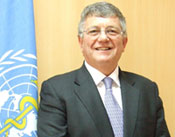
Additional information |
||
 | Data from the European Region | |
| Overview of confirmed cases in the European Region and maps | ||
 | Global situation - influenza A(H1N1) [WHO headquarters] | |
| Latest disease outbreak updates from WHO headquarters | ||
 | Influenza A(H1N1) [WHO headquarters] | |
| WHO information on the evolving situation. Provides access to both technical guidelines and information useful for the general public. | ||
 | Guidance documents | |
| For individuals, communities, national authorities and health professionals | ||
 | Frequently asked questions about influenza A(H1N1) [WHO headquarters] | |
| Basic information for the general public English, French and Russian | ||
 | How to protect yourself and others [pdf, 480KB] | |
| Poster for download and reprint | ||
| Also available in: fr[pdf, 488KB], de[pdf, 497KB], ru[pdf, 514KB] | ||
 | Current research on influenza A(H1N1) | |
| Collection of articles published in medical journals | ||
 | EISS Weekly Electronic Bulletin [external link] | |
| Weekly influenza surveillance report published by WHO/Europe and European Centre for Disease Prevention and Control based on data covering a total population of 883 million people | ||
 | European Centre for Disease Prevention and Control [external link] | |
 | European Commission [external link] | |
| Section on influenza A(H1N1) | ||
 | Media contacts | |
 | National authorities | |
 | WHO Regional Offices | |
 "As we have seen in recent weeks, the new influenza virus is spreading in Europe. WHO/Europe is supporting preparedness and response activities in countries to address the pandemic, procuring emergency laboratory supplies and medicines, providing training and bringing experts together to refine plans as the situation develops. Continued preparedness and careful monitoring are essential because influenza viruses are unpredictable. Although the pandemic could last a long time, we are working to minimize the impact on people and businesses." "As we have seen in recent weeks, the new influenza virus is spreading in Europe. WHO/Europe is supporting preparedness and response activities in countries to address the pandemic, procuring emergency laboratory supplies and medicines, providing training and bringing experts together to refine plans as the situation develops. Continued preparedness and careful monitoring are essential because influenza viruses are unpredictable. Although the pandemic could last a long time, we are working to minimize the impact on people and businesses."Dr Marc Danzon WHO Regional Director for Europe |
| Human cases of influenza A(H1N1) as of 17 June 2009, 06:00 GMT | |
|---|---|
| Laboratory-confirmed cases in the European Region (number of deaths in parentheses) |
2802 (1) |
| In 30 countries in the European Region Austria, Belgium, Bulgaria, Cyprus, Czech Republic, Denmark, Estonia, Finland, France, Germany, Greece, Hungary, Iceland, Ireland, Israel, Italy, Luxembourg, Netherlands, Norway, Poland, Portugal, Romania, Russian Federation, Slovakia, Spain, Sweden, Switzerland, Turkey, Ukraine and United Kingdom |
|
 | Over 2500 confirmed cases of influenza A(H1N1) in Europe | |
| 16 June 2009, 06:00 GMT As of 06:00 GMT on 16 June, 30 of the 53 Member States in the WHO European Region had reported a total of 2572 cases of influenza A(H1N1) to WHO/Europe. On 14 June 2009, the United Kingdom confirmed the first fatal case of influenza A(H1N1) in Europe, also the first outside the Americas. A woman diagnosed with influenza A(H1N1) virus infection, and with underlying health conditions, died in hospital in Scotland, United Kingdom. The vast majority of individuals with the virus have presented with mild illness. | ||
 | 30 countries have reported influenza A(H1N1): cases in Europe rise | |
| 11 June 2009, 22:00 GMT Since the update of 5 June, Ukraine has reported a new laboratory-confirmed case of influenza A(H1N1). As of 22:00 GMT on 11 June, 30 of the 53 countries in the WHO European Region had reported a total of 1803 cases to WHO/Europe. The number of reported cases increased by 89% from 5 to 11 June. On 11 June, WHO raised the level of influenza A(H1N1) pandemic alert to phase 6. The pandemic is characterized as of moderate severity. | ||
 | Influenza A (H1N1): pandemic alert phase 6 declared, of moderate severity | |
| 11 June 2009, 16:00 GMT Today WHO raised the level of influenza A(H1N1) pandemic alert to phase 6, as sustained community-level transmission of the virus is taking place in more than one region of the world. The pandemic is characterized as of moderate severity. Most of the cases have been mild, but even mild cases and the current level of severe cases could have a significant impact on health systems and society. | ||
 | Previous updates | |
| Updates on the influenza A(H1N1) situation since 24 april 2009 | ||